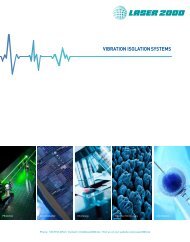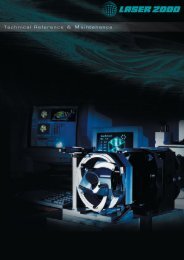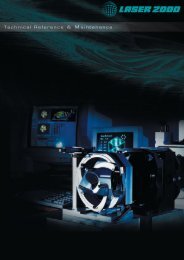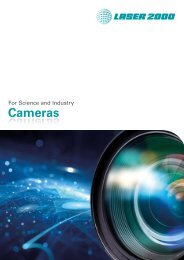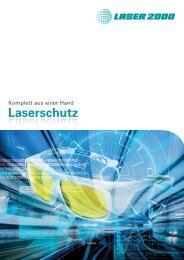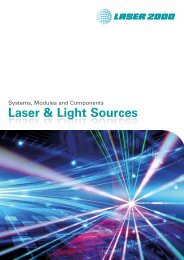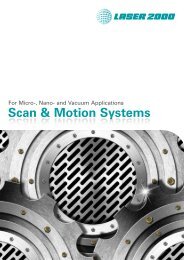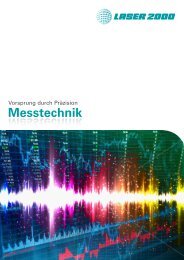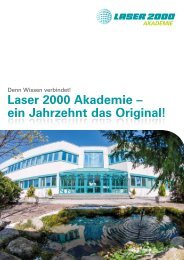Semrock Master Catalog 2018
Semrock Master Catalog 2018
Semrock Master Catalog 2018
You also want an ePaper? Increase the reach of your titles
YUMPU automatically turns print PDFs into web optimized ePapers that Google loves.
Qdot ® Single-band Filter Sets<br />
Filter Set /<br />
Primary Fluorophores<br />
Cell image courtesy of<br />
Thermo Fisher Scientific.<br />
Excitation<br />
(CWL/BW)<br />
Emission<br />
(CWL/BW)<br />
These single-band filter sets are specially optimized for<br />
brilliant, dense multi-color detection with Molecular<br />
Probes ® (Thermo Fisher Scientific) quantum dot nanocrystals.<br />
The highly transmitting, deep-blue exciter achieves maximum<br />
quantum dot excitation efficiency while virtually eliminating<br />
any DAPI or Hoechst excitation. And with the no burn-out<br />
reliability shared by all BrightLine ® filters, the permanent<br />
performance of these sets will outlast even your<br />
quantum dots!<br />
Dichroic<br />
(Edge)<br />
Filter Set Part Numbers /<br />
–ZERO Set Part Numbers<br />
QDLP-C (Longpass) 435/40 500/LP 510 nm QDLP-C-000 $785<br />
Qdot ®<br />
525, 565, 585, 605, 625, 655, 705, & 800 Nanocrystals<br />
Versatile and high brightness longpass filter set for viewing multiple Qdots<br />
QD525-C<br />
Qdot ® 525 Nanocrystals<br />
QD605-C<br />
Qdot ® 605 Nanocrystals<br />
QD625-C<br />
Qdot ® 625 Nanocrystals<br />
QD655-C<br />
Qdot ® 655 Nanocrystals<br />
See spectra graphs and ASCII data for these<br />
filter sets at www.semrock.com/Qdot.aspx<br />
435/40 525/15 510 nm QD525-C-000<br />
QD525-C-000-ZERO<br />
435/40 605/15 510 nm QD605-C-000<br />
QD605-C-000-ZERO<br />
435/40 625/15 510 nm QD625-C-000<br />
QD625-C-000-ZERO<br />
435/40 655/15 510 nm QD655-C-000<br />
QD655-C-000-ZERO<br />
Base Price /<br />
–ZERO Price<br />
$785<br />
$884<br />
$785<br />
$884<br />
$785<br />
$884<br />
$785<br />
$884<br />
Filter Specifications on page 34<br />
“–ZERO” denotes zero pixel shift performance (see page 36)<br />
Fluorophores<br />
Single-band<br />
Sets<br />
Multiband<br />
Sets<br />
Cubes<br />
Laser<br />
Sets<br />
TECHNICAL NOTE<br />
Fluorescence Imaging with Quantum Dot Nanocrystals<br />
Quantum dot nanocrystals are fluorophores that absorb photons of light and then re-emit<br />
longer-wavelength photons nearly instantaneously. However, there are some important<br />
differences between quantum dots (e.g., Qdot ®<br />
nanocrystals made by Thermo Fisher<br />
Scientific) and traditional fluorophores including organic dyes and naturally fluorescing<br />
proteins. Quantum dots are nanometer-scale clusters of semiconductor atoms, typically<br />
coated with an additional semiconductor shell and then a polymer coating to enable coupling<br />
to proteins, oligonucleotides, small molecules, etc., which are then used for direct binding of<br />
the quantum dots to targets of interest.<br />
Nanocrystals are extremely bright and highly photostable, making them ideal for applications that require<br />
high sensitivity with minimal label interference, as well as long-term photostability, such as live-cell imaging and dynamic<br />
studies. Their excellent photostability also means they are fixable and archivable for permanent sample storage in pathology<br />
applications. Because there is a direct relationship between the size of a nanocrystal and the wavelength of the emitted<br />
fluorescence, a full range of nanocrystals can be made – each with a narrow, distinct emission spectrum and all excited by a<br />
single blue or ultraviolet wavelength. Thus nanocrystals are ideal for dense multiplexing. Some important nanocrystal features<br />
that may limit certain applications include their fairly large physical size and long lifetime.<br />
Transmission (%)<br />
100<br />
90<br />
80<br />
70<br />
60<br />
50<br />
40<br />
30<br />
20<br />
10<br />
0<br />
350 400 450 500 550 600 650 700<br />
Wavelength (nm)<br />
Figure 1. Structure of a nanocrystal.<br />
To take advantage of nanocrystal features, it is important to use properly<br />
optimized filters. <strong>Semrock</strong> offers BrightLine ®<br />
filter sets specially optimized for<br />
the most popular quantum dot imaging applications. A universal set with a<br />
long-wave-pass emitter enables simultaneous imaging of multiple quantum<br />
dots by eye or with a color camera. Additionally, filter sets tailored to individual<br />
quantum dots are also available (see filter sets above). Best of all, these filters<br />
share the incredible “no burn-out” reliability of all BrightLine filters, an ideal<br />
match for highly photostable quantum dot nanocrystals!<br />
Figure 2. A universal exciter provides superior excitation efficiency while avoiding the excitation of DAPI<br />
and undesirable autofluorescence. This filter is combined with a dichroic beamsplitter with extremely wide<br />
reflection and transmission bands for maximum flexibility, and narrow, highly transmitting emission filters<br />
matched to each of the most important Qdot wavelengths.<br />
NLO<br />
Filters<br />
Individual<br />
Filters<br />
Dichroic<br />
Beamsplitters<br />
Tunable<br />
Filters<br />
21<br />
More



